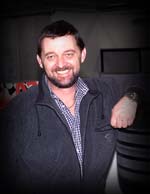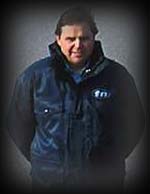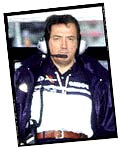Team Principals
 Chairman & Ceo - Paul Stoddart
Chairman & Ceo - Paul Stoddart
If ever the term "entrepreneur" applied to an individual, that person is Paul Stoddart. The Australian-born, UK-domiciled businessman appears to have the uncanny knack of turning almost every commercial opportunity that presents itself into a highly successful venture.
A self-confessed "petrol-head" and former racer, his latest move has been to acquire the Minardi Formula One team, the perennially hard-trying Italian outfit having fallen on particularly difficult times following the withdrawal of a major sponsor at the end of the 2000 season.
Stoddart's plan is to put the well-equipped Minardi operation at Faenza together with his own formidable European Formula Racing operation at Ledbury, in the UK, and slowly but surely mould the new team into a serious contender in the ultra-competitive world of Formula One.
And anyone who has even an inkling of his track record will know better than to bet against the plain-speaking, 45-year-old Stoddart succeeding in his quest to build a new Grand Prix powerhouse. His European Aviation empire had annual sales in 2000 of £75 million and is currently one of Europe's fastest-growing regional airlines, while his aircraft spares business, also based at Ledbury in a purpose-built 118,000 sq ft facility, is one of Europe's largest suppliers of aircraft spares and numbers many major airlines among its regular customers.
Leaving school at 14, because he simply couldn't wait any longer to get out into the "real" world and start working, this entirely self-made man now possesses a 35-strong fleet of aircraft that boasts two Airbus A300s, 20 BAC 1-11s, and 13 Boeing 737s, and carries over a million passengers a year. His speciality is "wet leases" - leasing aircraft and crews to other airlines - the appeal of this sort of turn-key operation being demonstrated by the fact European Aviation's customer base currently includes 30 national and secondary airlines throughout Europe. Always with an eye open for the next potential business opportunity, however, Stoddart now has his sights firmly set on providing a similar service to airlines in a number of former eastern bloc countries.
Add to that list of accomplishments the creation last year of his own Formula 3000 team, which finished third overall in the championship standings at the end of its first full season of competition, and the instigation of a novel two-seater Grand Prix car build programme, which aims to bring the experience of F1 performance within the reach of members of the general public, and the range and depth of Paul Stoddart's fertile mind begins to become clear.
But just when did he get his "big break"? It came in 1989, a scant three years after the ambitious young businessman had sold up "Down Under", including his motoring and aviation interests, and moved to the UK in search of bigger challenges. Initially setting up a small group of new-car franchises, he was doing "adequately well" before an amazing opportunity presented itself. The Royal Australian Air Force had decided to sell off five "low-mileage" aircraft from its fleet - two BAC 1-11s and three Falcon 20 business jets - the "job lot" including what eventually turned out to be 48 shipping containers full of very valuable spares.
Taking a decision that reflects perfectly his ongoing business philosophy, Stoddart spotted an opportunity, raised every penny he could, and took a large, but calculated risk by buying the aircraft. They were soon in service in Europe, and when the EAL 1-11s were augmented four years later with a further 20 similar aircraft acquired from British Airways, Stoddart was on his way. He was in the happy position of possessing a fleet of BAC 1-11s plus enough spares to keep them flying for ages, with enough left over to become the largest supplier of 1-11 spares in the world. Most importantly, he had accomplished all this at "bargain-basement" prices and could boast an airline with the lowest operating costs in Europe.
It was to provide the financial "springboard" for everything that has followed, and will follow in the future, for make no mistake: Paul Stoddart has major plans and ambitions yet unfulfilled, and he is determined they will become reality.
 Sporting Director - Rupert Manwaring
Sporting Director - Rupert Manwaring
With vast experience of Formula One and a strong working relationship with Paul Stoddart dating back to 1997, it was no surprise that 44-year-old Rupert Manwaring was appointed Sporting Director when Stoddart began to assemble a management team in the wake of his purchase of the Minardi Team in January 2001.
British-born Manwaring laid the roots for his motor-racing career when he pursued engineering studies at Sussex University with a view to securing a career in motor racing. Following his introduction to the sport at Surtees, where he rose to the position of Assistant Team Manager after initially joining as a draftsman, Manwaring's dedication and attention to detail brought him to the attention of Brabham Team Manager, Herbie Blash, who hired him in 1979 as Spares Coordinator for the charismatic team, owned by Bernie Ecclestone.
He continued in this role through 1982, assuming additional responsibilities in the areas of purchasing and new projects, before being promoted to Assistant Team Manager, and then Team Manager, in the course of the next two seasons. During his time at Brabham, the team won two World Championships.
In 1985, Manwaring made what has been his sole foray to date outside of Formula One, when he set up and ran the UK arm of the Kraco Indy car (CART) team. Directing a team of nine, he oversaw the design and construction of the team's own chassis, delivering the project on schedule and within budget.
He returned to Formula One in 1986, as Assistant Team Manager for the newly formed Beatrice organisation, his role including overall responsibility for team logistics. His next move was to the equivalent position at Team Lotus. By 1989, he had become Team Manager with overall responsibility for operations, hiring, equipment and financial planning for both the race and test teams.
Moving to the Tyrrell Racing Organisation in 1991, Manwaring continued to fill the role of Team Manager for four more years, before expanding his horizons and taking on the position of Commercial Director. Over the next three years, his responsibilities increased, to include the areas of marketing and communications. He was directly involved in introducing sponsors such as Nokia, ICL Fujitsu, Brother, YKK and PIAA to the world of Formula One, while also proving himself adept at dealing with the political aspects of modern Grand Prix racing.
Following the sale of Tyrrell to British American Racing, Manwaring moved to Honda Racing Development (HRD) in the autumn of 1998, to become Head of Racing for the Japanese company's exploratory Formula One project. It was a position that he held until Honda management decided in mid-1999 that its immediate future in Grand Prix racing lay with supplying engines rather than designing and building its own cars.
He then took on a number of motor racing consultancy projects until snapped up by Paul Stoddart to join his European Minardi F1 project as Sporting Director, making him No 2 in the management structure of this exciting new team and allowing him to bring to bear on the project the full range of his skills, acquired during nearly a quarter of a century in the sport
 General Manager - Gian Carlo Minardi
General Manager - Gian Carlo Minardi
Gian Carlo Minardi grew up in the midst of cars: his family manage Fiat (since 1927), Iveco and Selenia dealerships, as well as an Agip fuel station. His passion for racing undoubtedly came from his father Giovanni, who in 1948 built the GM 75, a small two-seater with a 6-cylinder 750 cc engine designed by Oberdan Golfieri. It was therefore inevitable that Gian Carlo Minardi should himself take up racing. In 1968 he bought a Fiat 500 Group A tuned by Faccioli, in which he competed in various uphill events and achieved some very decent results. After a brief interlude in rallying, at the wheel of a Fiat 124, and several meets for classic cars, he hung up his helmet and devoted his energies to Scuderia del Passatore, a Faenza-based team competing in the minor formulas.
From 1972 to 1974 Gian Carlo Minardi ran Scuderia del Passatore, achieving excellent results in Formula Italia: Giancarlo Martini was crowned runner-up in the 1972 championship and lifted the title in 1973.
In 1975 the team was renamed Scuderia Everest and made its debut in the F.2 European championship.
It was at this time that the team entered into collaboration with Ferrari, which gave Minardi a F1 312 B3 to wean emerging talent on the Italian motor racing scene. In the meantime the minor formulas continued to bring satisfaction with Leoni and Martini; Martini won the Italian F2 championship title in 1976. In 1977 Ferrari gave the Faenza-based team the Dino V6 engines which powered the Ralts driven by Leoni and Gianfranco Brancatelli and, in 1978, the Chevrons driven by Elio De Angelis, Clay Regazzoni and Miguel Angel Guerra.
In 1980 Minardi became a constructor himself, forming the Minardi Team together with the engineers Giacomo Caliri and Luigi Marmiroli. Three brilliant seasons in F2 followed, with drivers like Beppe Gabbiani, Johnny Cecotto, Michele Alboreto (who won the European race at Misano in 1981), Alessandro Nannini and Paolo Barilla.
The shareholder structure changed when Piero Mancini took over from the Caliri-Marmiroli pairing. In 1984 Minardi began preparing for the move up to Formula One, which it made the following year and in which it still competes, after 15 seasons.
During this time the Team's cars were powered by various engines, from the Ford Cosworth (in various versions) to Motori Moderni, from Ferrari to Lamborghini, right through to the Brian Hart engine, giving a small group of talented newcomers the opportunity to experience F1 at the start of their careers. The drivers launched in Formula One by Minardi include such names as Alessandro Nannini, Pierluigi Martini, Gianni Morbidelli, Christian Fittipaldi, Giancarlo Fisichella, Jarno Trulli and the very young Esteban Tuero, who made his debut in F1 last year aged 19.
Gian Carlo Minardi worked alongside Gabriele Rumi as a General Director of the team until the year 2000. At the end of January 2001, the Italian outfit was acquired by the UK-based, Australian-born head of the European Aviation Group, Paul Stoddart. Gian Carlo Minardi continues as a Director of the Faenza-based team, focussing particularly on young driver development, an area in which he is acknowledged to have great expertise
The Drivers
Click on the thumbnail to view the image in full size
![]()

![]()
